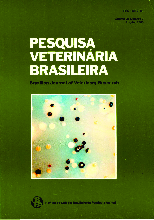 |
|
|
|
Year 2000 - Volume 20, Number 2
|

|
Salmonella serovars in meat of horses slaughtered in northeastern Brazil., 20(2):80-84
|
ABSTRACT.- Hofer E., Zamora M.R.N., Lopes A.E., Moura A.M.C:, Araújo H.L., Leite M.D.D. & Silva Filho S.J. 2000. [Salmonella serovars in meat of horses slaughtered in northeastern Brazil.] Sorovares de Salmonella. em carne de eqüídeos abatidos no nordeste do Brasil. Pesquisa Veterinária Brasileira 20(2):80-84. Depto Bacteriologia, Instituto Oswaldo Cruz/FIOCRUZ, Rio de janeiro, RJ 21045-900, Brazil.
In the sixties and seventies there was an extraordinary increase in export of horse meat products to Europe andjapah. This favored an increase in risk of Salmonella outspread through those products to human and animal consumer populations. Thus, from an exporting company dealing with horse meat located in northeastern Brazil (state of Pernambuco), 19,238 fragments of more external muscles, Salmonella was isolated from 666 samples colleted from 433 animals (horses and donkeys). The serotyping of 745 isolates showed 98 serovars pertaining to 14 serogroups, predominantly classified into subspecies 1 (98.9%). S. Anatum, S. Carrau, S. Saintpaul, S. Agona, and S. Typhimurium were the most frequent serovars isolated. Preliminary data indicate that the primary causes for the presence of Salmonella in the meats probably was contact with feces from slaughtered animals, as well a.s possible contamination of environments, in view of the absence of human carriers researched in part of the personnel. |
| |
|
|
| |
|
 |